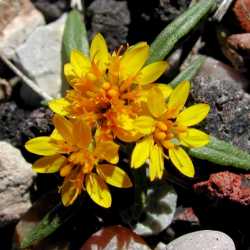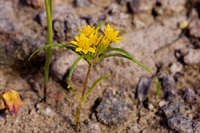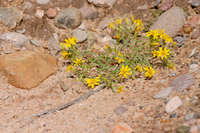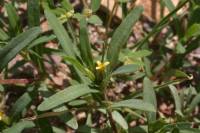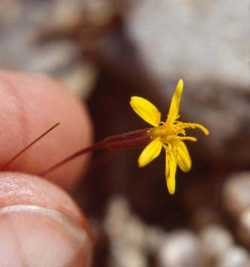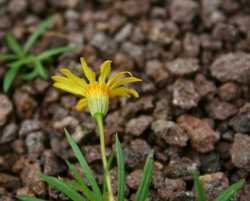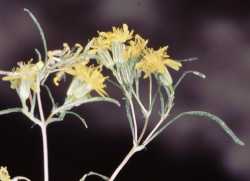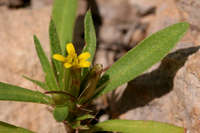Annuals or perennials, 1-120 cm (herbage often lemon or spicy scented). Stems prostrate to erect, simple to much branched. Leaves cauline; opposite; usually sessile; blades mostly linear to elliptic, oblanceolate, oblong, or obovate, margins usually setose-ciliate (mostly near bases), faces glabrous or hairy (abaxial and/or margins dotted with oil-glands). Heads radiate, borne singly or in congested to open, cymiform arrays (peduncles usually bracteate). Calyculi 0. Involucres campanulate, cylindric, ellipsoid, or fusiform, 2-8+ mm diam. Phyllaries 3-15[-21] in 1 series (usually distinct, falling individually, each with a ray cypsela, sometimes cohering at bases, falling together as units enclosing all cypselae of a head; individually convex, indurate-keeled, narrowly to broadly hyaline-margined, apices often ciliolate, bearing oil-glands on margins and/or faces). Receptacles flat to hemispheric, smooth or pitted, epaleate. Ray florets 3-15[-21], pistillate, fertile (inserted on phyllary bases); corollas yellow, often reddened abaxially (often drying white to purplish; laminae elliptic, entire or 2- or 3-lobed, glabrous or proximally glandular-puberulent). Disc florets [1-]3-55[-100], usually bisexual; corollas yellow (sometimes drying white to purplish), tubes shorter than narrowly funnelform throats, lobes (4-)5, deltate to lance-ovate (lobes ± equal and corollas actinomorphic, not 2-lipped, or lobes unequal with 3 or 4 forming an adaxial lip opposite 1-lobed lip and corollas zygomorphic, 2-lipped, all lobes glabrous or proximally glandular-puberulent; anther bases rounded or subcordate, apical appendages rounded or emarginate; styles included to long-exserted, branches ± papillose knobs). Cypselae (blackish or dark brown) cylindric to narrowly clavate, ribbed or angled, puberulent to pilose; pappi persistent, usually of awns, bristles, or scales, sometimes coroniform. x = 12.
Pectis is unusual among Compositae in having the C4 photosynthetic pathway and the accompanying Kranz anatomy-leaves with vascular bundle sheath cells that contain numerous chloroplasts (B. N. Smith and B. L. Turner 1975). All of the closely related genera have the C3 pathway. The selective advantage imparted by C4 photosynthesis (greatly reduced photorespiration in bundle sheath cells) has enabled Pectis species to occupy a variety of hot, dry habitats including deserts, tropical and subtropical grasslands, arid scrublands, and tropical beaches. Some species of Pectis grow in hot desert areas of the western United States following summer precipitation. Leaves and phyllaries in all Pectis species are dotted with embedded pellucid glands (here called oil-glands). In some species, the liquid within the schizogenous cavities includes a mixture of strongly scented monoterpenes; in other species the gland contents have little or no aroma. Herbage containing strongly scented essential oils are described as 'lemon-scented' when citral is the predominant compound and 'spicy-scented' when other oils are predominant. For most taxa the odor (or lack thereof) of the crushed herbage is a readily apparent field characteristic. Unfortunately, labels of most herbarium specimens lack information on odor. Intact glands on herbarium specimens may retain liquid contents for years; odors may change as the specimens age. On living specimens, the glands are translucent; on herbarium specimens, they tend to be golden brown or blackish. The glands probably function as a deterrent to herbivores, including insects. Ray florets of Pectis are inserted directly onto the bases of the phyllaries, and the phyllaries and ray cypselae tend to fall together when the heads shatter at maturity. The numbers of phyllaries and ray florets per Pectis capitulum vary along the Fibonacci series and rarely deviate from the sequence (i.e., in Pectis, the modal numbers of phyllaries and rays are 3, 5, 8, 13, and 21). Pectis coulteri Harvey & A. Gray has been attributed in floras to California and Arizona on the basis of the ambiguously labeled type collection ('California,' without locality or date, T. Coulter 331, holotype TCD) and speculations as to its origin. This species is known to occur only from central Sonora to northern Sinaloa, Mexico, and has never been documented in the United States. The type was probably collected in Sonora (D



